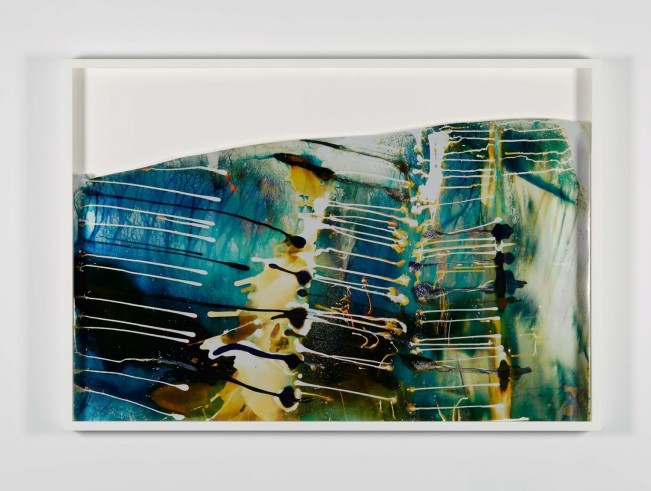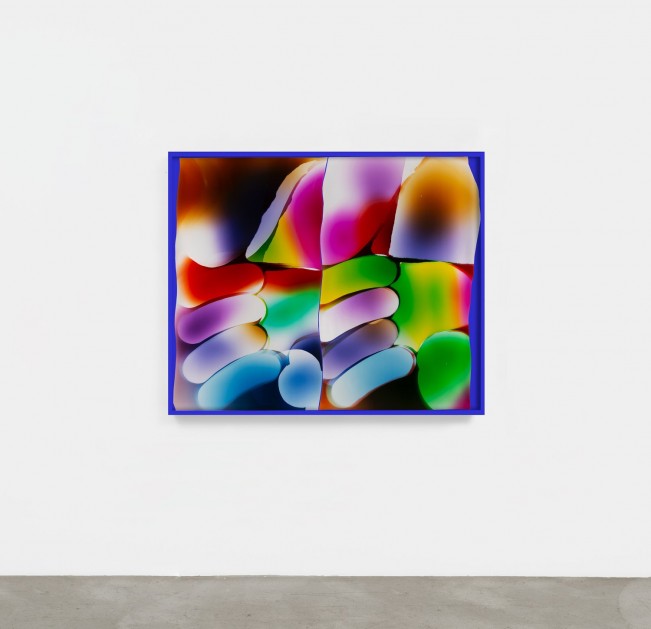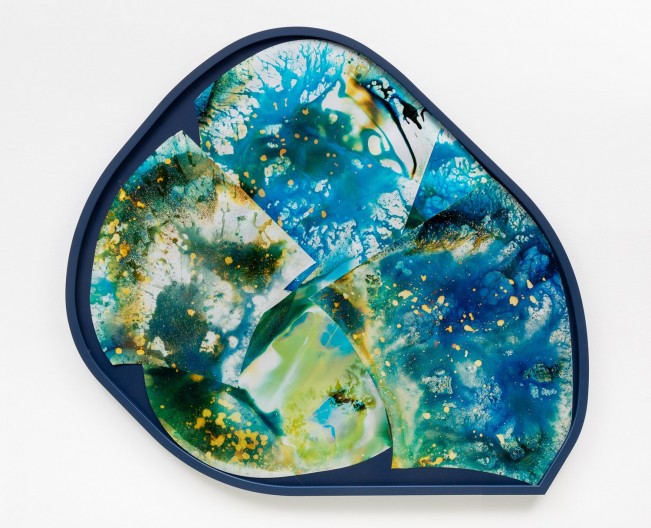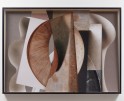Mariah Robertson in Conversation with Douglas Breault
Mariah Robertson is an artist from New York City who revels in the uncertainty conjured from tangling darkroom processes and materials. The formal scientific approach of handling film processing chemicals are instead mixed, dripped, and exposed in the darkroom to create radiant auras of color and forms that poke at the edges of how a photograph can be defined. The tension of the works lies in the simultaneous homage to the origin of photography itself while also subverting the careful precision of photographs grounded in direct observation of life. The viewer becomes hypnotized by the scale and beauty of the work, often deviating from the rectangle to engulf your own body with the tactility of the surface alchemies.
I first learned about Mariah Robertson and her work while watching Art 21 videos on YouTube when I was in college. Like many artists, I was intrigued by the idea of breaking some rules in the studio. Rules can feel like a boundary between how you imagine an idea and how you get there creatively. Robertson exudes charm and humor in the video as she explains the complicated rhythms she’s deciphered in the darkroom to conjure the volcanic reactions that develop on the surface. The characteristics of the artwork are a step-sibling to painting, having some resemblances but ultimately its own identity, and celebrates the enchanting tones only color processing chemistry can achieve as the materials become increasingly extinct. It is fascinating when the pendulum swings back to seemingly obscure techniques of image making while the culture of photography feels so enthralled with technological advancements in digital photography.
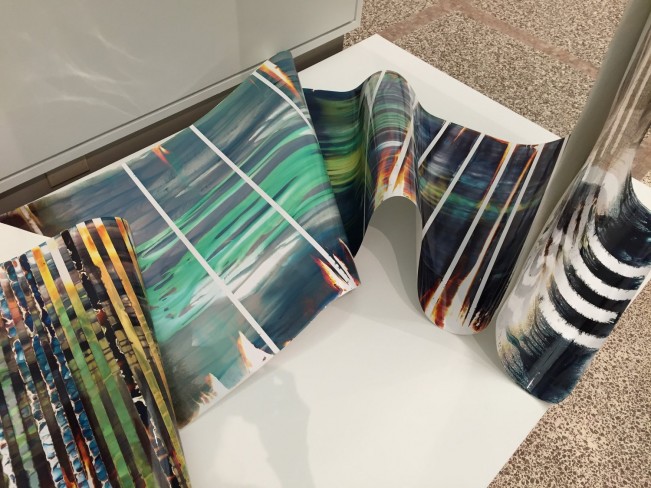
©Mariah Robertson, “2017, 341, 343, 353, 367, 369,” 2022 , Chemical treatment on RA-4 paper in frame
Robertson’s work agitates the potential of the darkroom to coalesce layers of amorphous colors, patterns, and images. The oscillating colors are undeniably emotional, rendering beauty through skewed perception to drop a dose of magic into the viewer’s imagination. Her process would make a photography purist nauseous because of the assumed haphazard approach, but the precision lies in where chance and material expertise intersect. I constantly revisit Mariah’s work in search of a dose of bravery for my own practice. Her fearless embrace of saturated color knocks you out with beauty and wonder, then continues to unfold to reveal the density of layers to speculate how the image came to fruition. The lure to her work is in the unknowing, the abstraction taking the lead, but offering the process of making photographs itself inherently valuable in arriving at the mysterious concoctions on the surface.
Photographs are often understood as a relic that outlives the photographer. What do you think your images and process will say about you as an artifact over time?
Thinking about this kind of thing wakes me up in the middle of the night with anxiety panic. I could have a more relaxed, circumspect view of the matter, but then I would probably not have been the type of person drawn deep into photography. Most of my art practice is consumed by one long project which uses analysis of photography as a model analytic inquiry generally. I have a lot of patience and fascination for photography and frustration with the culture OF photography, so it is not a chore to spend great amounts of time taking certain questions to logical or extreme ends.
Do you feel your work has a kinship with the history of painting or is resolutely footed in the history and potential of photography?
This question about painting is a natural one. The immediate emotional effect of the abstract work can be similar to that of similarly sized, abstract works. That response is a very important human one, not to be discounted, but I am hoping there is more for the person who is interested to go further. Obviously, a bunch of drippy color blobs is going to remind a person of what they are most likely to have seen before, which is paint. Liquid only behaves in so many ways on this planet. At first glance or on a small image like a phone, a bunch of colors made from internal chemical reactions are going to look like paint. And I have painter friends who do not accept that this is so different from painting. Without being dismissive, it seems to me that painting is communicating by building a series of marks. The real work of mine is the set of questions being asked and the work is all detritus that is spit out from those questions. It’s all by-product. That’s probably true of painting though if you are good at it. I’m actually trying to figure out this question lately by trying to replicate some photograms of mine in spray paint. It’s so weird! It feels so different and so wrong, but probably because I am bad at it. It’s a really interesting exercise.
What is the one photographic material or chemistry you would love to get your hands on?
I never got to work with cibachrome. Everyone once in a while I read an old book that refers to something I’ve never heard of before and is long gone. Kodak discontinued my favorite metallic paper, and its replacement radiance as well. But one must practice acceptance and move on.
Mariah Robertson lives and works in Brooklyn, New York. She is represented by M+B Gallery in Los Angeles, CA and Van Doren Waxter Gallery in New York, NY. Her work can be seen currently in Direct Contact: Cameraless Photography Now, The Sidney and Lois Eskenazi Museum of Art at Indiana University February 16–July 9, 2023 and in The Sky’s the Limit at the National Museum of Women in the Arts, October 21, 2023 – February 25, 2024. Robertson will be having a solo show at Van Doren Waxter Gallery, September 2023.
Follow Mariah Robertson on Instagram @robertsonmariah
Douglas Breault is an interdisciplinary artist who overlaps elements of photography, painting, sculpture, and video to merge spaces both real and imagined. His work has been collected, published, and exhibited nationally and internationally, including at the Museum of Fine Arts Boston, the Czong Institute for Contemporary Art (South Korea), Space Place Gallery (Russia), the Bristol Art Museum, the Rochester Museum of Fine Arts, Amos Eno Gallery, and VSOP Projects. Breault has been an artist in residence at MassMoca and AS220 and was awarded the Montague Travel Grant to study in London and Paris in 2017. Douglas is a professor of art at Babson College and Bridgewater State University, and he has been a guest critic at MassArt, Wellesley College, Kansas City Art Institute, and the Slade College of Art, among others. Douglas is the Exhibitions Director at Gallery 263 in Cambridge, MA. He received his MFA from the School of the Museum of Fine Arts at Tufts University and a BA in Studio Art from Bridgewater State University, and he currently divides his time between Boston, MA, and Providence, RI.
Follow Douglas Breault on Instagram @dug_bro
Posts on Lenscratch may not be reproduced without the permission of the Lenscratch staff and the photographer.
Recommended
-
Bill Armstrong: All A Blur: Photographs from the Infinity SeriesNovember 17th, 2025
-
Robert Rauschenberg at Gemini G.E.LOctober 18th, 2025
-
Erin Shirreff: Permanent DraftsAugust 24th, 2025
-
Shelagh Howard: The Secret KeepersJuly 7th, 2025
-
Michelle Leftheris: Time, Nature & TechnologyJune 11th, 2025


